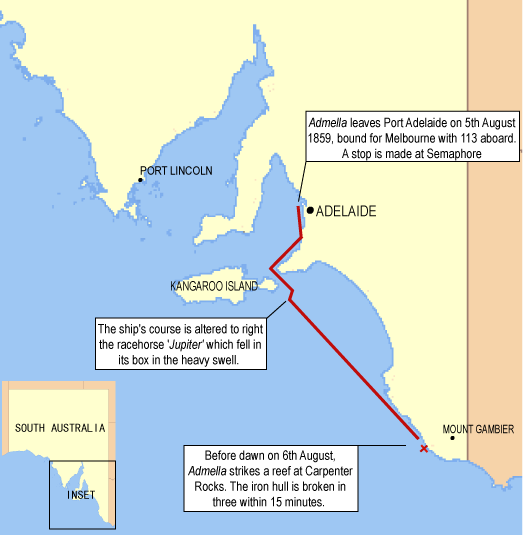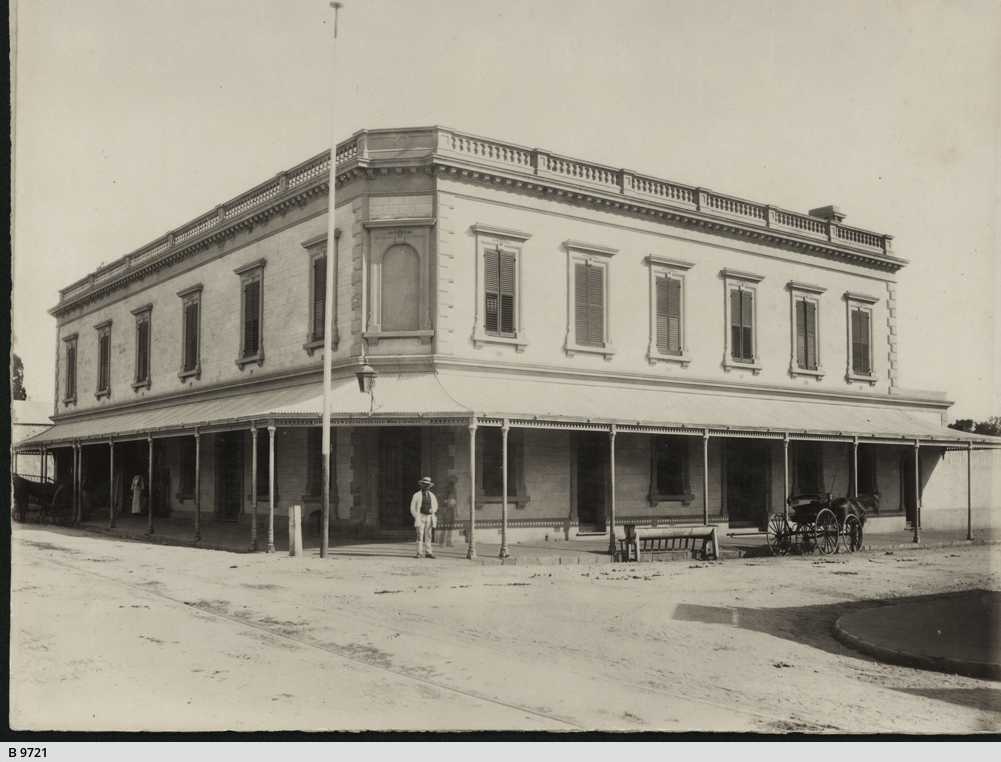|
James Shaw (artist)
James Shaw (12 January 1815 – 1 September 1881) was a Scottish painter, photographer, engraver, lithographer, surveyor, and lawyer. He was also an early colony of South Australia, colonist of South Australia. Biography Shaw was born on 12 January 1815 at Dumfries, Scotland to James and Isabella Shaw. His father was a clerk and proofreader who painted for pleasure, and his brother George Baird Shaw. Shaw went to Edinburgh Royal High School, and then studied law at the University of Edinburgh. In September 1836, sponsored by Justice Thomas McCornock, he left Edinburgh for Jamaica to be a bookkeeper. He painted in his free time. When people realised his talent, they started to ask him for commissions. In 1841, he became a surveyor and began taking portrait commissions. In 1847, Shaw learned photography and became a photographer. He married Janet Liddle Paterson on 5 July 1850. Together, they moved to Adelaide in the colony of South Australia. Janet died suddenly in 1868 aged ... [...More Info...] [...Related Items...] OR: [Wikipedia] [Google] [Baidu] |
Adelaide
Adelaide ( ) is the capital city of South Australia, the state's largest city and the fifth-most populous city in Australia. "Adelaide" may refer to either Greater Adelaide (including the Adelaide Hills) or the Adelaide city centre. The demonym ''Adelaidean'' is used to denote the city and the residents of Adelaide. The Traditional Owners of the Adelaide region are the Kaurna people. The area of the city centre and surrounding parklands is called ' in the Kaurna language. Adelaide is situated on the Adelaide Plains north of the Fleurieu Peninsula, between the Gulf St Vincent in the west and the Mount Lofty Ranges in the east. Its metropolitan area extends from the coast to the foothills of the Mount Lofty Ranges, and stretches from Gawler in the north to Sellicks Beach in the south. Named in honour of Queen Adelaide, the city was founded in 1836 as the planned capital for the only freely-settled British province in Australia. Colonel William Light, one of Adelaide's foun ... [...More Info...] [...Related Items...] OR: [Wikipedia] [Google] [Baidu] |
Landscape Artists
Landscape painting, also known as landscape art, is the depiction of natural scenery such as mountains, valleys, trees, rivers, and forests, especially where the main subject is a wide view—with its elements arranged into a coherent composition. In other works, landscape backgrounds for figures can still form an important part of the work. Sky is almost always included in the view, and weather is often an element of the composition. Detailed landscapes as a distinct subject are not found in all artistic traditions, and develop when there is already a sophisticated tradition of representing other subjects. Two main traditions spring from Western painting and Chinese art, going back well over a thousand years in both cases. The recognition of a spiritual element in landscape art is present from its beginnings in East Asian art, drawing on Daoism and other philosophical traditions, but in the West only becomes explicit with Romanticism. Landscape views in art may be entirely ... [...More Info...] [...Related Items...] OR: [Wikipedia] [Google] [Baidu] |
1881 Deaths
Events January–March * January 1– 24 – Siege of Geok Tepe: Russian troops under General Mikhail Skobelev defeat the Turkomans. * January 13 – War of the Pacific – Battle of San Juan and Chorrillos: The Chilean army defeats Peruvian forces. * January 15 – War of the Pacific – Battle of Miraflores: The Chileans take Lima, capital of Peru, after defeating its second line of defense in Miraflores. * January 24 – William Edward Forster, chief secretary for Ireland, introduces his Coercion Bill, which temporarily suspends habeas corpus so that those people suspected of committing an offence can be detained without trial; it goes through a long debate before it is accepted February 2. * January 25 – Thomas Edison and Alexander Graham Bell form the Oriental Telephone Company. * February 13 – The first issue of the feminist newspaper ''La Citoyenne'' is published by Hubertine Auclert. * February 16 – The Canadi ... [...More Info...] [...Related Items...] OR: [Wikipedia] [Google] [Baidu] |
1815 Births
Events January * January 2 – Lord Byron marries Anna Isabella Milbanke in Seaham, county of Durham, England. * January 3 – Austria, Britain, and Bourbon-restored France form a secret defensive alliance treaty against Prussia and Russia. * January 8 – Battle of New Orleans: American forces led by Andrew Jackson defeat British forces led by Sir Edward Pakenham. American forces suffer around 60 casualties and the British lose about 2,000 (the battle lasts for about 30 minutes). * January 13 – War of 1812: British troops capture Fort Peter in St. Marys, Georgia, the only battle of the war to take place in the state. * January 15 – War of 1812: Capture of USS ''President'' – American frigate , commanded by Commodore Stephen Decatur, is captured by a squadron of four British frigates. February * February – The Hartford Convention arrives in Washington, D.C. * February 3 – The first commercial cheese factory is founded in S ... [...More Info...] [...Related Items...] OR: [Wikipedia] [Google] [Baidu] |
Stephen King (surveyor)
Stephen King (15 December 1841 – 8 October 1915) was an English sketcher, surveyor, and explorer. He was part of the last John McDouall Stuart Expedition (1861–1862), successfully crossing Australia from south to north, and was appointed Surveyor of the Overland Telegraph party sent out by Darwent and Dalwood in 1870. He was called Stephen King Jr. during the lifetime of his father, a pioneer of Gawler, and to a lesser extent continued through his life. His father has been called here and elsewhere Stephen King JP. Stephen King JP King was born at Holton le Clay, Lincolnshire, England on 17 August 1806, the eldest son of Stephen King Sr., farmer, of Kelby, near Braceby, Lincolnshire and his wife Hannah née Witty. He followed his father as a farmer and grazier in Lincolnshire, and married Martha, the fifth daughter of William Robinson, of Ashwell, Rutland, and had one daughter Matilda. The three of them migrated to South Australia aboard ''Orleana'', arriving in January ... [...More Info...] [...Related Items...] OR: [Wikipedia] [Google] [Baidu] |
Cape Banks
Cape Banks is a headland in the Australian state of South Australia located in the gazetted locality of Carpenter Rocks at the south end of Bucks Bay and the north end of Bungaloo Bay on the state's south east coast about west south west of the city of Mount Gambier. The cape is described by one source as being "a rocky point, high, SSE of Cape Buffon" while another source describes it as ‘a cuspate foreland protruding seaward in lee of calcarenite rocks and reefs’. It was named by the Royal Navy officer, James Grant, on 3 December 1800. The navigation aid known as the Cape Banks Lighthouse is not located on the cape but on an unnamed headland located at the northern end of Lighthouse Bay which is the next bay to the north-west of Bucks Bay. Cape Banks, South Australia, should not be confused with the northern headland of Botany Bay Botany Bay (Dharawal: ''Kamay''), an open oceanic embayment, is located in Sydney, New South Wales, Australia, south of the Sy ... [...More Info...] [...Related Items...] OR: [Wikipedia] [Google] [Baidu] |
Art Gallery Of South Australia
The Art Gallery of South Australia (AGSA), established as the National Gallery of South Australia in 1881, is located in Adelaide. It is the most significant visual arts museum in the Australian state of South Australia. It has a collection of almost 45,000 works of art, making it the second largest state art collection in Australia (after the National Gallery of Victoria). As part of North Terrace cultural precinct, the gallery is flanked by the South Australian Museum to the west and the University of Adelaide to the east. As well as its permanent collection, which is especially renowned for its collection of Australian art, AGSA hosts the annual Festival of Contemporary Aboriginal and Torres Strait Islander Art known as ''Tarnanthi'', displays a number of visiting exhibitions each year and also contributes travelling exhibitions to regional galleries. European (including British), Asian and North American art are also well represented in its collections. the Director of A ... [...More Info...] [...Related Items...] OR: [Wikipedia] [Google] [Baidu] |
Admella
SS ''Admella'' was an Australian passenger steamship that was shipwrecked on a submerged reef off the coast of Carpenter Rocks, south west of Mount Gambier South Australia, in the early hours of Saturday 6 August 1859. Survivors clung to the wreck for over a week and many people took days to die as they glimpsed the land from the sea and watched as one rescue attempt after another failed. With the loss of 89 lives, mostly due to cold and exposure, it is one of the worst maritime disasters in Australian history. ''Admella'' disaster remains the greatest loss of life in the history of European settlement in South Australia. Of the 113 on board 24 survived, including only one woman, Bridget Ledwith. Of the 89 dead, 14 were children. The 150th anniversary of the disaster was marked in August 2009 by events across the south east of South Australia and at Portland, Victoria. Description and career SS ''Admella'' (so named for her circuit Adelaide, Melbourne, Launceston) was built by L ... [...More Info...] [...Related Items...] OR: [Wikipedia] [Google] [Baidu] |
South Australian Society Of Arts
The South Australian Society of Arts was a society for artists in South Australia, later with a royal warrant renamed The Royal South Australian Society of Arts in 1935. History A meeting of persons interested in the formation of a society for the promotion of the fine arts was held on Monday evening 13 October 1856 at the Adelaide School of Arts, in Pulteney Street. Owing to the inclemency of the weather very few persons were present. Mr James MacGeorge took the chair. Letters were read from Mr. Fisher, M.L.C., Mr. Tomkinson, Mr. J. Howard Clark, Mr. C. A. Wilson, expressing regret at being unable to attend, but expressing approval of the objects sought to be attained by that meeting. The following resolutions were passed unanimously:— That a Society, to be called the South Australian Society of Arts, be now formed, 'The annual payment of one guinea shall entitle the subscriber to all the benefits of membership, consisting in free admission to all lectures, meetings, and exhibit ... [...More Info...] [...Related Items...] OR: [Wikipedia] [Google] [Baidu] |
Kensington, South Australia
Kensington is a suburb of Adelaide, South Australia in the City of Norwood, Payneham & St Peters council area. Unlike the rest of the city, Kensington's streets are laid out diagonally. Second Creek runs through and under part of the suburb, which contains many heritage buildings as well as Norwood Swimming Pool. History The village of Kensington was surveyed in November 1838 by J.H. Hughes, the first in the immediate area, and was named after Kensington Palace. First Anglican bishop Augustus Short first lived in Kensington after his arrival in December 1847, on the corner of Bishop's Place and Regent Street. The Colonial Secretary, then Alfred Mundy, lived in Kensington in 1848. This was before the village of Marryatville was developed over the road to the south. The Kensington line was the first of several trams in Adelaide, firstly horse-drawn (1878) and later electrified. Location and governance Kensington lies approximately due east of Adelaide city centre. Nearby su ... [...More Info...] [...Related Items...] OR: [Wikipedia] [Google] [Baidu] |






